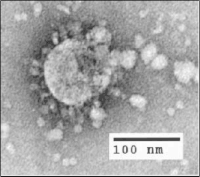
Photo from wikipedia
Severe acute respiratory syndrome coronavirus 2 (SARS-CoV-2) emerged in 2019 and then rapidly led to a pandemic with widespread cases of SARS and excess mortality. In response, mitigation efforts (including… Click to show full abstract
Severe acute respiratory syndrome coronavirus 2 (SARS-CoV-2) emerged in 2019 and then rapidly led to a pandemic with widespread cases of SARS and excess mortality. In response, mitigation efforts (including social distancing, quarantining, and closing of businesses and schools) have resulted in an unprecedented economic downfall. There is concern that these environmental stressors, augmented by psychological factors, such as loss of control, fear of death and dying, and isolation, are contributing to the emergence of psychiatric outcomes of the coronavirus disease 2019 (COVID-19) pandemic.1 Furthermore, coronaviruses may induce cognitive, emotional, neurovegetative, and behavioral dysregulation through biological mechanisms, including direct neuroinvasion and triggering of immune activation. Increasing evidence has linked immune activation with depression and suicidal behavior, and according to several large meta-analyses, anti-inflammatory approaches have demonstrated efficacy in treating depression.2 Many infections involving hospital contact are predictively associated with suicide, and maximum behavioral effects can take more than 6 months postinfection to fully develop.3 This suggests priming of cellular immune substrates rather than immediate effects. Priming is defined as an alteration (most often enhancement) of subsequent responses by an initial stimulus and involves cellular morphological and physiological changes. Priming by immune activation that is triggered by infection (ie, first hit) may not necessarily induce persistent psychiatric syndromes in itself. Yet it may progressively increase sensitivity to common proinflammatory stimuli (ie, second hit), which include other mild infections, concussions, airborne allergen and pollutant exposure, and psychological stressors. In addition, coronaviruses seem capable of directly invading the central nervous system (CNS)4,5 via neural and hematogenous routes. The neural pathways involve the transport of the virus to the CNS from the nasal cavity and rhinopharynx via the olfactory and trigeminal nerves and from the lower respiratory tract via the vagus nerves.4 The hematogenous neuroinvasion occurs via the bloodstream and encompasses 3 components dependent on which cell is infected by coronaviruses on their path toward the CNS. These include (1) leukocytes (predominantly monocytes) that serve as a vehicle of dissemination into the CNS, (2) endothelial cells belonging to the blood-brain barrier, or (3) endothelial cells of the blood–cerebrospinal fluid barrier located in the ventricles of the brain, more specifically in the choroid plexus.4 While our biological and clinical understanding of SARS-CoV-2 and COVID-19 is increasing at a very rapid pace, several key domains remain poorly understood. First, we do not know the nature of SARS-CoV-2 immunity and if it conveys prevention of infection (sterilizing immunity) or prevention of symptomatic disease (protective immunity) and for how long. Second, although some genetic, demographic, and clinical risk factors have been uncovered and await replication, we do not yet understand the sources of the considerable heterogeneity in the clinical manifestations and severity of the disease. SARS-CoV-2 and its predecessor SARS-CoV-1 gain intracellular access through binding of their spike proteins to angiotensin-converting enzyme 2 (ACE2), expressed predominantly in the alveolar epithelia of the lungs, the epithelia of other tissues, and brain endothelia. This led to the obvious hypothesis that ACE2 may hold the key to coronavirus invasiveness and severity of illness. However, binding to ACE2 is not necessary for either a high severity of respiratory or systemic illness or for neurological and psychiatric outcomes of coronaviruses. For instance, the Middle East respiratory syndrome coronavirus (MERS-CoV) does not use ACE2 to gain intracellular access and yet causes severe respiratory and systemic illness as well as neurological and psychiatric outcomes.1 Conversely, although human coronavirus NL63 does bind to ACE2, it causes only benign upper respiratory infections. Yet individuals seropositive for human coronavirus NL63 have markedly elevated odds of mood disorders relative to seronegative individuals.6 Whatever its mechanism, a severe course of COVID-19 is a panorgan medical condition, with widespread vasculopathies as a common denominator. It involves biological factors that elevate the risk and severity of neurological and early neuropsychiatric outcomes, such as massive cytokine storms, severe endothelial barrier dysfunction, hypercoagulability leading to thrombosis or thromboembolism, hypoxemia, electrolyte and pH abnormalities, failure of the gut-blood barrier, and increased neuroinvasion. It is likely that those with a severe course of infection have a higher level of exposure to very severe stress relative to those with mild or asymptomatic infection, including fear of death and dying. Severe trauma and emerging posttraumatic stress disorder, late psychiatric conditions with high incidence after COVID-19,1 are also known to induce robust pathophysiological abnormalities in the endocrine systems of stress and arousal regulation that further augVIEWPOINT
Journal Title: JAMA psychiatry
Year Published: 2020
Link to full text (if available)
Share on Social Media: Sign Up to like & get
recommendations!